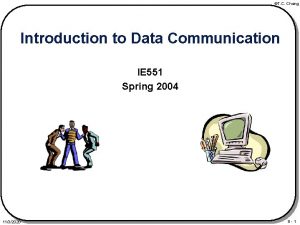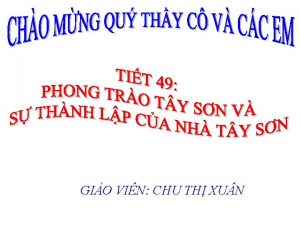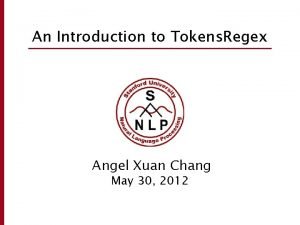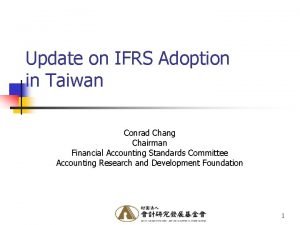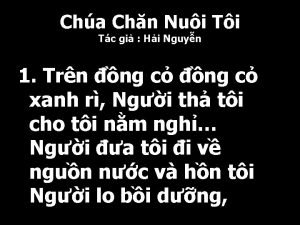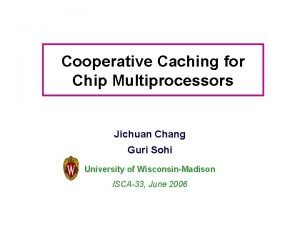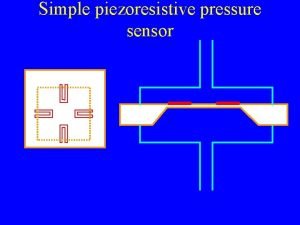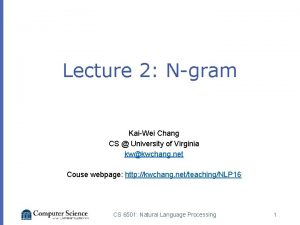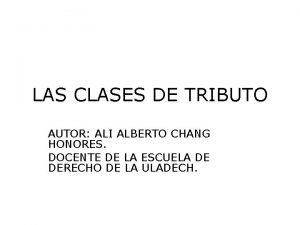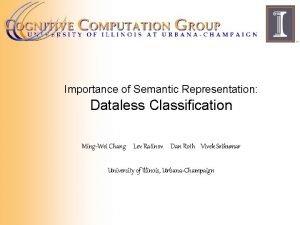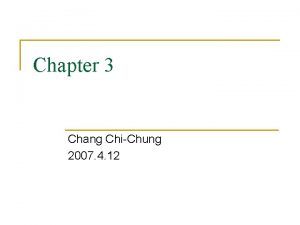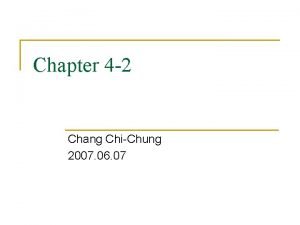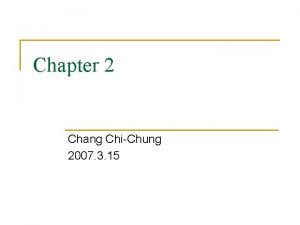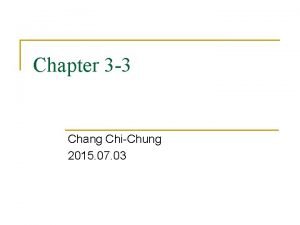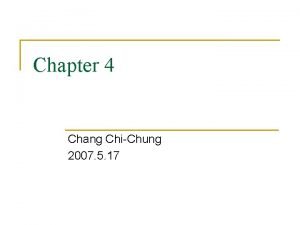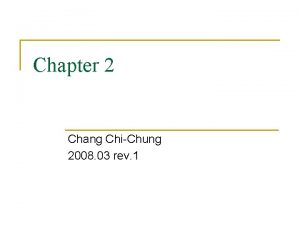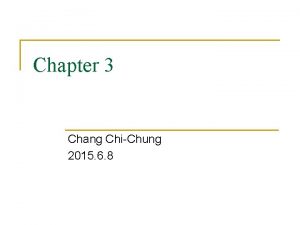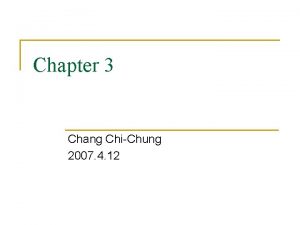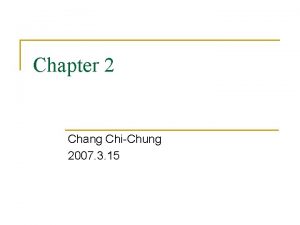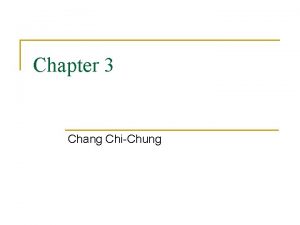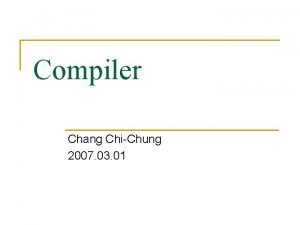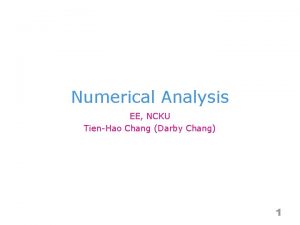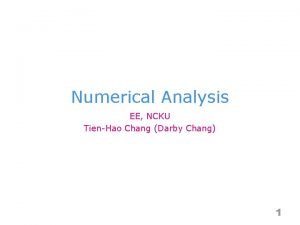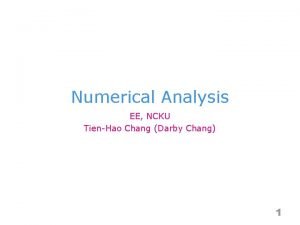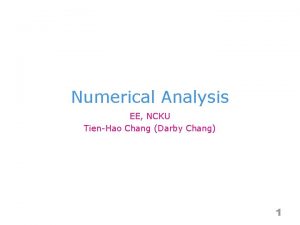Chapter 6 Graph Chang ChiChung 2011 17 Graph

























![Adjacency Lists Head. Nodes [0 ][1 ][2 ] [3 ] 3 1 2 0 Adjacency Lists Head. Nodes [0 ][1 ][2 ] [3 ] 3 1 2 0](https://slidetodoc.com/presentation_image/3aaa547af3d6f5fe6cd8cf647db1baf6/image-26.jpg)
![Adjacency Lists H 1 Head. Nodes [0 ][1 ][2 ] [3 ][4 ][5 ][6 Adjacency Lists H 1 Head. Nodes [0 ][1 ][2 ] [3 ][4 ][5 ][6](https://slidetodoc.com/presentation_image/3aaa547af3d6f5fe6cd8cf647db1baf6/image-27.jpg)
![Inverse Adjacency Lists [0 ][1 ][2 ] 0 1 0 2 0 0 0 Inverse Adjacency Lists [0 ][1 ][2 ] 0 1 0 2 0 0 0](https://slidetodoc.com/presentation_image/3aaa547af3d6f5fe6cd8cf647db1baf6/image-28.jpg)

















- Slides: 45

Chapter 6 Graph Chang Chi-Chung 2011. 17

Graph n 圖(graph) 的定義 G = (V, E) l V為頂點的集合 l E為邊的集合,以頂點對表示 n 有向圖和無向圖 l Undirected graph (graph) edge (u, v) = (v, u) l Directed graph (digraph) edge <u, v> ≠ <v, u>

Examples: Graphs (a) G 1 (b) G 2 (c) G 3 0 0 0 1 1 2 3 V(G 1) = {0, 1, 2, 3} E(G 1) = {(0, 1), (0, 2), (0, 3), (1, 2), (1, 3), (2, 3)} 3 2 4 5 1 6 V(G 2) = {0, 1, 2, 3, 4, 5, 6} E(G 2) = {(0, 1), (0, 2), (1, 3), (1, 4), (2, 5), (2, 6)} Undirected Graph 2 V(G 3) = {0, 1, 2} E(G 3) = {<0, 1>, <1, 0>, <1, 2>} Directed Graph

Graph 分支度 degree 3 連接 incident 相鄰 adjacent 頂點 vertax 邊 edge 無向圖 undirected graph 有向圖 directed graph

Simple Graph n No self edges (self loops,自我迴路) l A graph may not have an edge from a vertex, v, back to itself. n No multiple edges (多重邊或平行邊) l A graph may not have multiple occurrences of same edges. 0 0 1 1 2 (a) Graph with a self edge 3 2 (b) Multigraph

Complete Graph n The number of distinct unordered pairs (u, v) with u≠v in a graph with n vertices is n(n-1)/2. n Complete graph l Undirected graph uan n-vertex graph with exactly n(n-1)/2 edges. l Directed graph uan n-vertex graph with exactly n(n-1) edges K 4 K 3

Adjacent and Incident n Undirected graph l If (u, v) is an edge in E(G), vertices u and v are adjacent and the edge (u, v) is the incident on vertices u and v. n Directed graph l <u, v> indicates u is adjacent to v and v is adjacent from u. l <u, v> is incident to u and v. 0 0 1 3 2 4 5 1 6 2

子圖 Subgraph n A subgraph of G is a graph G’ such that V(G’) V(G) and E(G’) E(G). 0 1 0 0 2 1 (1) (2) 1 2 2 3 (3) 3 0 0 1 2 3 (6) (7) (8) 0 0 (5) 1 0 1 1 (4) 2 2 1

Path and Length n Path l A path from vertex u to vertex v in graph G is a sequence of vertices u, i 1, i 2, …, ik, v, such that (u, i 1), (i 1, i 2), …, (ik, v) are edges in E(G). l G’ is directed graph, <u, i 1>, <i 1, i 2>, …, <ik, v> are edges in E(G’). n Length l The length of a path is the number of edges on it. n Simple Path l A simple path is a path in which all vertices except possibly the first and last are distinct. n A path (0, 1), (1, 3), (3, 2) can be written as 0, 1, 3, 2.

Cycle n A cycle is a simple path in which the first and last vertices are the same. n Similar definitions of path and cycle can be applied to directed graphs.

Examples: Path, Simple Path, Cycle 0 1 2 Path 1 (0, 1) (1, 3) (3, 4) (4, 2) (2, 1) (1, 4) (4, 5) Path 2 (0, 1) (1, 3) (3, 4) (4, 5) Path 3 (1, 3) (3, 4) (4, 2) (2, 1) 3 4 Simple Path Circle 5 Path 2、Path 3


Example: Connected and Strongly Connected H 1 H 2 0 1 5 2 3 4 6 7 G 3 0 0 1 1 2 2




Spanning Trees & Complete Graph K 4





重要的觀念 n 圖的表示方法 (資料結構) l 邊串列 (edges lists) l 鄰接串列 (adjacency lists) l 鄰接矩陣 (adjacency matrix) n 圖的走訪 (traversal) l DFS (深先搜尋,depth-first search) l BFS (廣先搜尋,breadth-first search)



![Adjacency Lists Head Nodes 0 1 2 3 3 1 2 0 Adjacency Lists Head. Nodes [0 ][1 ][2 ] [3 ] 3 1 2 0](https://slidetodoc.com/presentation_image/3aaa547af3d6f5fe6cd8cf647db1baf6/image-26.jpg)
Adjacency Lists Head. Nodes [0 ][1 ][2 ] [3 ] 3 1 2 0 2 3 0 0 1 3 0 0 0 1 2 0 G 1 ] 1 2 3 0 Head. Nodes [0 ][1 ][2 0 1 0 2 0 0 1 0 G 2 2
![Adjacency Lists H 1 Head Nodes 0 1 2 3 4 5 6 Adjacency Lists H 1 Head. Nodes [0 ][1 ][2 ] [3 ][4 ][5 ][6](https://slidetodoc.com/presentation_image/3aaa547af3d6f5fe6cd8cf647db1baf6/image-27.jpg)
Adjacency Lists H 1 Head. Nodes [0 ][1 ][2 ] [3 ][4 ][5 ][6 ] [7 ] 2 1 0 3 0 0 0 3 0 1 1 0 5 0 6 4 0 5 7 0 6 0 G 3 0 1 2 3 G 3 H 2 4 5 6 7
![Inverse Adjacency Lists 0 1 2 0 1 0 2 0 0 0 Inverse Adjacency Lists [0 ][1 ][2 ] 0 1 0 2 0 0 0](https://slidetodoc.com/presentation_image/3aaa547af3d6f5fe6cd8cf647db1baf6/image-28.jpg)
Inverse Adjacency Lists [0 ][1 ][2 ] 0 1 0 2 0 0 0 1 2 G 2 [0] 1 0 [1] 0 0 [2] 1 0 求入分支度須用此反轉串列

Adjacency Lists : Sequential Representation H 1 H 2 0 1 2 5 3 0 1 2 3 4 4 6 7 G 3 5 6 7 8 9 9 11 13 15 17 18 20 22 23 2 各頂點紀錄起始位置 10 11 12 13 14 15 16 17 18 19 20 1 0 3 4 3 0 1 各頂點連接的頂點 2 5 6 5 21 22 7 6

0 Adjacency Lists: Orthogonal List 1 tail head column link for head row link for tail 2 head nodes (shown twice) 0 1 0 0 1 2 1 0 0 0 1 2 0 0

Multilists 0 1 2 3 m vertex 1 vertax 2 list 1 list 2 Head. Nodes [0 ][1 ][2 ] [3 ] The lists are Vertex 0: N 0 -> N 1 -> N 2 Vertex 1: N 0 -> N 3 -> N 4 Vertex 2: N 1 -> N 3 -> N 5 Vertex 3: N 2 -> N 4 -> N 5 N 0 0 1 N 3 edge (0, 1) N 1 0 2 N 3 edge (0, 2) N 2 0 3 0 N 4 edge (0, 3) N 3 1 2 N 4 N 5 edge (1, 2) N 4 1 3 0 N 5 edge (1, 3) N 5 2 3 0 edge (2, 3) 0


Adjacency Matrix n Adjacency Matrix is a two dimensional n×n array. 0 0 1 2 1 3 2 (a) G 1 (b) G 2

Adjacency Matrix H 1 0 1 2 3 G 4 H 2 4 5 6 7 (c) G 3

Depth-First Search 0 0, 1, 3, 7, 4, 5, 2, 6 1 3 Head. Nodes [0 ] [1 ][2 ] [3 ] [4 ] [5 ] [6 ] [7] 1 0 0 1 1 2 2 3 5 7 7 4 2 4 5 7 0 4 0 6 0 0 0 5 6 0 6

DFS Algorithm DFS(G, v) Input: A graph G and a vertx v of G Output: A labeling of the edges in the connected component of v as discovery edges and back edges for all edges e in G. incident. Edges(v) do if edge e is unexplored then w G. opposite(v, e) if vertax w is unexplored then label e as a discovery edge recursively call DFS(G, w) else label e as a back edge



計算雙連通成分 G DE EC H CD J CF E D F I C B M A KL K HJ EC FG JG GH IF CM MA AB MB BC KA HI L CK


Breadth-First Search 0, 1, 2, 3, 4, 5, 6, 7 1 3 Head. Nodes [0 ] [1 ][2 ] [3 ] [4 ] [5 ] [6 ] [7] 1 0 0 1 1 2 2 3 0 2 3 5 7 7 4 2 4 5 7 0 4 0 6 0 0 0 5 6 0 6

BFS Algorithm BFS(G, v) Input: A graph G and a vertx s of G Output: A labeling of the edges in the connected component of s as discovery edges and cross edges create an empty container L 0 insert s into L 0 i 0 while Li is not empty do create an empty container Li+1 for each vertax v in Li do for all edge e in G. incident. Edges(v) do if edge e is unexplored then let w be the other endpoint of e if vertax w is unexplored then label e as a discovery edge insert w into Li+1 else label e as a cross edge i i+1



 Joe chang
Joe chang Tc chang
Tc chang Requirements engineering a roadmap
Requirements engineering a roadmap Darrick chang icfo
Darrick chang icfo Kai-wei chang
Kai-wei chang Brief chang brendan playerunknownjaewon
Brief chang brendan playerunknownjaewon Fay chang
Fay chang Khởi nghĩa chàng lía nổ ra ở đâu
Khởi nghĩa chàng lía nổ ra ở đâu Bor-yuh evan chang
Bor-yuh evan chang Ching chang walla walla bing bang song
Ching chang walla walla bing bang song Pien fu traditional chinese clothing
Pien fu traditional chinese clothing Yuyen chang
Yuyen chang Paoti chang
Paoti chang Hee chang trading co., ltd.
Hee chang trading co., ltd. Winnie chang fiu
Winnie chang fiu Zeinab chahine
Zeinab chahine Chang wah
Chang wah Chang pui chung memorial school
Chang pui chung memorial school Thêu giáp tỉa
Thêu giáp tỉa Ai yi fan
Ai yi fan Angel x chang
Angel x chang Conrad chang
Conrad chang Rong chang dictation
Rong chang dictation Ksk+
Ksk+ Chia hui chang
Chia hui chang Chẳng may em đánh vỡ một lọ hoa đẹp
Chẳng may em đánh vỡ một lọ hoa đẹp Trên đồng cỏ xanh rì người cho tôi nằm nghỉ
Trên đồng cỏ xanh rì người cho tôi nằm nghỉ Post classical east asia
Post classical east asia Chang'an
Chang'an Johan chang
Johan chang Chẳng nhìn thấy ve đâu
Chẳng nhìn thấy ve đâu Chang horing
Chang horing Language change theories
Language change theories Chia hui chang
Chia hui chang Jichuan chang
Jichuan chang Chemistry by raymond chang 10th edition
Chemistry by raymond chang 10th edition Chang cgi
Chang cgi Remco chang
Remco chang Eileen chang love in a fallen city summary
Eileen chang love in a fallen city summary Rieka chang jiang
Rieka chang jiang Adxl 50
Adxl 50 Wilke chang
Wilke chang Ph chang
Ph chang Kai wei chang
Kai wei chang Alberto chang
Alberto chang Ming-wei chang
Ming-wei chang

